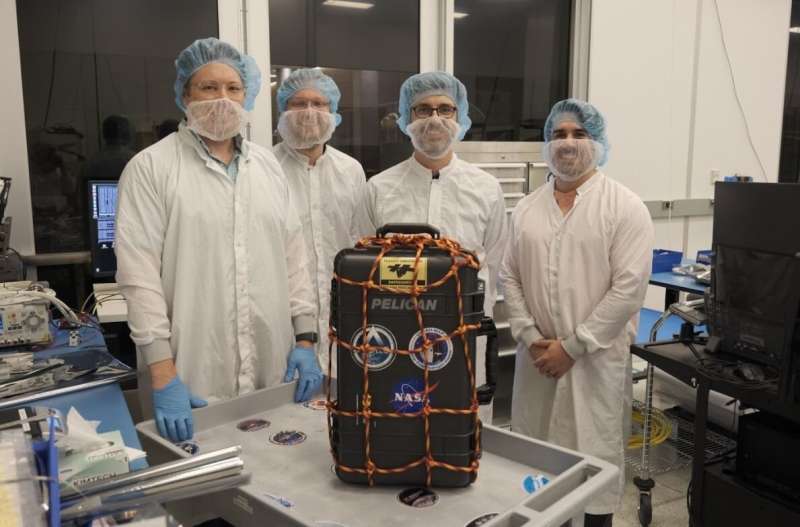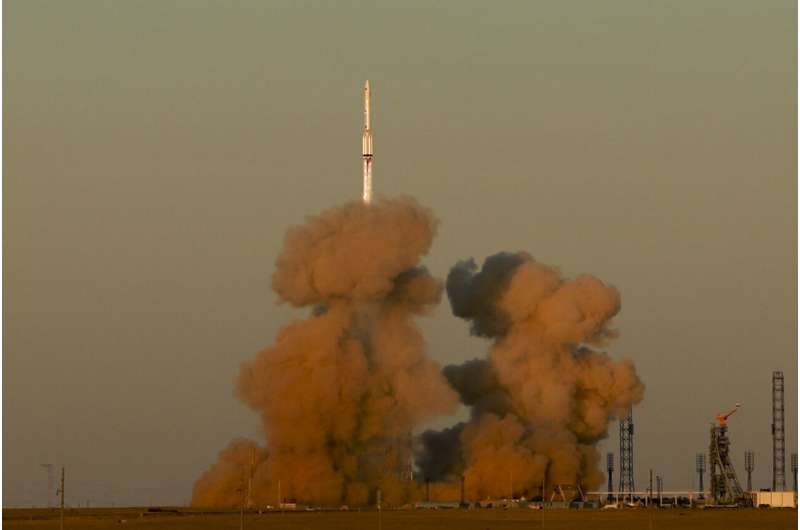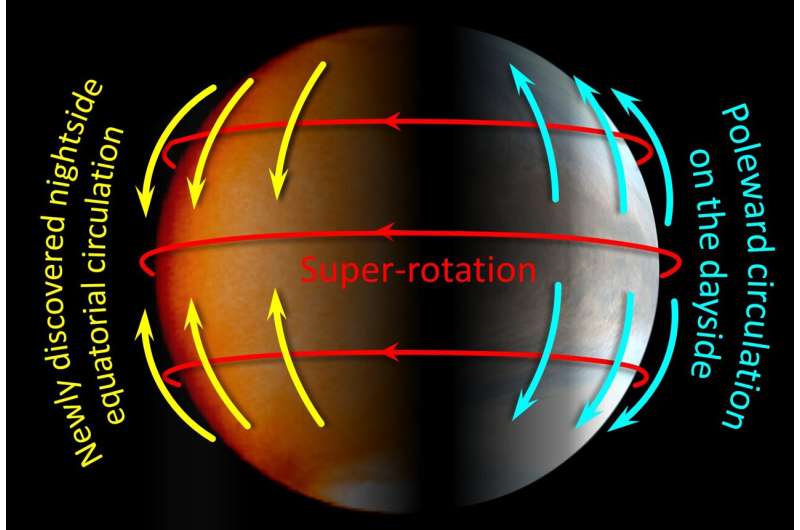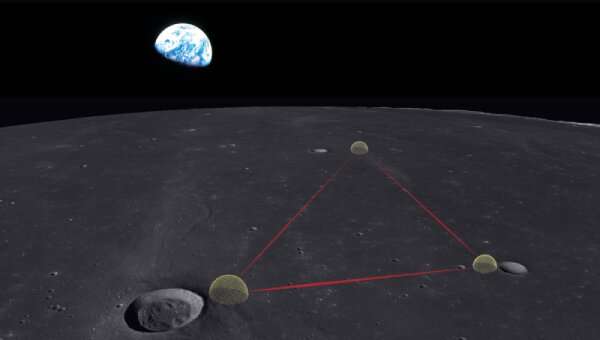Russia launches Nauka module to International Space Station
Wednesday, 21 July 2021 20:33
EL PASO, Texas — Russia launched a long-delayed module for its segment of the International Space Station July 21, but that module reportedly suffered technical problems after reaching orbit.
A Proton-M rocket lifted off from the Baikonur Cosmodrome at 10:58 a.m.
LunaH-Map spacecraft safely delivered to NASA's Kennedy Space Center
Wednesday, 21 July 2021 17:14
The ASU-led team that built NASA's Lunar Polar Hydrogen Mapper, or "LunaH-Map" for short, has safely delivered their spacecraft to NASA's Kennedy Space Center in Florida in preparation for a launch expected later this year on NASA's Space Launch System (SLS) Artemis I rocket.
LunaH-Map is a fully functional interplanetary spacecraft about the size of a large cereal box and weighing about 30 pounds. It is the first mission to be led, designed, assembled, integrated, tested and delivered from the ASU Tempe campus. Its destination is in orbit around the moon, from which it will map water-ice in permanently shadowed regions of the lunar south pole.
Russia launches lab module to International Space Station
Wednesday, 21 July 2021 15:40
Peterson, Schriever, Cheyenne Mountain to become Space Force bases
Wednesday, 21 July 2021 14:47
WASHINGTON — Peterson Air Force Base, Schriever Air Force Base and Cheyenne Mountain Air Force Station will officially become U.S. Space Force bases.
These Colorado-based installations are home to the largest concentration of Space Force personnel.
ERA launch replay
Wednesday, 21 July 2021 14:15 Video:
00:03:07
Video:
00:03:07
The European Robotic Arm (ERA) is on its way to the International Space Station after being launched on a Proton rocket from the Baikonur Cosmodrome, in Kazakhstan, at 16:58 CEST on 21 July 2021.
The 11-m-long robot is travelling folded and attached to what will be its home base – the Multipurpose Laboratory Module, also called ‘Nauka’. The Proton-M booster placed Nauka and ERA into orbit around 10 minutes after liftoff, nearly 200 km above Earth.
The International Space Station already has two robotic arms; Canadian and Japanese robots play a crucial role in berthing spacecraft and transferring payloads and astronauts. However, neither
Space-based infrared imaging reveals the nighttime weather on Venus
Wednesday, 21 July 2021 14:00
Little is known about Venus weather at night, as the absence of sunlight makes imaging difficult. Now, researchers have devised a way to use infrared sensors on board the Venus orbiter Akatsuki to reveal the first details of the nighttime weather of our nearest neighbor. Their analytical methods could be used to study other planets including Mars and gas giants as well. Furthermore, the study of Venusian weather granted by their methods could allow researchers to learn more about the mechanisms underpinning Earth's weather systems.
Astrophysicist outlines plans for a gravitational wave observatory on the moon
Wednesday, 21 July 2021 13:47
Vanderbilt astrophysicist Karan Jani has led a series of studies that make the first case for a gravitational wave infrastructure on the surface of the moon. The experiment, dubbed Gravitational-Wave Lunar Observatory for Cosmology, uses the moon's environment and geocentric orbit to analyze mergers of black holes, neuron stars and dark matter candidates within almost 70 percent of the entire observable volume of the universe, he said.
"By tapping into the natural conditions on the moon, we showed that one of the most challenging spectrum of gravitational waves can be measured better from the lunar surface, which so far seems impossible from Earth or space," Jani said.
"The moon offers an ideal backdrop for the ultimate gravitational wave observatory, since it lacks an atmosphere and noticeable seismic noise, which we must mitigate at great cost for laser interferometers on Earth," said Avi Loeb, professor of science at Harvard University and bestselling author of books about black holes, the first stars, the search for extraterrestrial life and the future of the universe.
Accion Systems gets new owner to scale up propulsion system
Wednesday, 21 July 2021 12:01
TAMPA, Fla. — Tracker Capital, a venture capital firm linked to the group that bought hypersonic vehicle maker Stratolaunch, has taken a majority stake in space propulsion startup Accion Systems.
New York-based Tracker Capital acquired 51% of Accion Systems after leading its $42 million funding round, supporting plans to scale up its Tiled Ionic Liquid Electrospray (TILE) thrusters for larger satellites.
View from Juno during its flyby of Ganymede and Jupiter
Wednesday, 21 July 2021 11:57
Visualizations shape how we perceive space exploration. Whether it's the Pale Blue Dot, the Hubble Ultra Deep Field, Earthrise, or any other myriad images captured as part of this great endeavor, they all help inspire the next generation of explorers. Now, with advances in image capture and processing technology, we can finally start to take the next step in those visualizations—video. Ingenuity was recently captured on video during its first flight a few months ago. And this week, NASA released a breathtaking video of Juno's view of Jupiter and Ganymede, one of its moons, as it flew past the gas giant.
The views themselves are stunning, with lightning flashing on Jupiter's night side and Ganymede's textured terrain coming across in full force.
Op-ed | Commerce Department, NOAA ensuring U.S. remains a world leader in space commerce
Wednesday, 21 July 2021 11:17
The United States has long been a leader in space and will continue to do so. This is why in his first 100 days in office, President Biden renewed the National Space Council, which is led by Vice President Harris, to synchronize the nation’s civil commercial and national security space activities.
ESA advances Vega rocket evolution beyond 2025
Wednesday, 21 July 2021 11:00
ESA will further increase the competitiveness and environmental sustainability of Europe’s Vega launch system beyond 2025 through a contract signed with Avio in Italy.
Perseverance rover begins hunt for signs of Martian life
Wednesday, 21 July 2021 10:44 NASA's Mars 2020 Perseverance rover has begun its search for signs of ancient life on the Red Planet. Flexing its 7-foot (2-meter) mechanical arm, the rover is testing the sensitive detectors it carries, capturing their first science readings. Along with analyzing rocks using X-rays and ultraviolet light, the six-wheeled scientist will zoom in for closeups of tiny segments of rock surfaces that
NASA's Mars 2020 Perseverance rover has begun its search for signs of ancient life on the Red Planet. Flexing its 7-foot (2-meter) mechanical arm, the rover is testing the sensitive detectors it carries, capturing their first science readings. Along with analyzing rocks using X-rays and ultraviolet light, the six-wheeled scientist will zoom in for closeups of tiny segments of rock surfaces that Roscosmos says US greenlit import of Russia's RD-181M rocket engines
Wednesday, 21 July 2021 10:44 The United States has approved the purchase of a new batch of the Russian-made RD-181M space rocket engines, a spokesman for the Russian space agency Roscosmos, Vladimir Ustimenko, said on Tuesday.
"The US government has approved the contract between NPO Energomash [Roscosmos subsidiary] and US Orbital Sciences LLC company. This means that there will be new supplies of engines and new laun
The United States has approved the purchase of a new batch of the Russian-made RD-181M space rocket engines, a spokesman for the Russian space agency Roscosmos, Vladimir Ustimenko, said on Tuesday.
"The US government has approved the contract between NPO Energomash [Roscosmos subsidiary] and US Orbital Sciences LLC company. This means that there will be new supplies of engines and new laun AFRL conducts 1,300 experiments on record-breaking satellite
Wednesday, 21 July 2021 10:44 The Air Force Research Laboratory is celebrating the completion of the Demonstration and Science Experiments (DSX) satellite mission, and processing a treasure trove of valuable data that will be studied by scientists for many years to come.
The spacecraft was launched June 25, 2019 from Cape Canaveral Space Force Station after 16 years of development, integration, and testing.
"Most
The Air Force Research Laboratory is celebrating the completion of the Demonstration and Science Experiments (DSX) satellite mission, and processing a treasure trove of valuable data that will be studied by scientists for many years to come.
The spacecraft was launched June 25, 2019 from Cape Canaveral Space Force Station after 16 years of development, integration, and testing.
"Most Cool flames created during a first for ISS research
Wednesday, 21 July 2021 10:44 Cool flames, flames that burn at extremely low temperatures, are nearly impossible to create in Earth's gravity. However, they are easily produced in the microgravity environment of the International Space Station.
Non-premixed cool flames, created when fuel and oxidizer are not mixed before reacting, were discovered in 2012 aboard the space station during the Flame Extinguishment (FLEX) s
Cool flames, flames that burn at extremely low temperatures, are nearly impossible to create in Earth's gravity. However, they are easily produced in the microgravity environment of the International Space Station.
Non-premixed cool flames, created when fuel and oxidizer are not mixed before reacting, were discovered in 2012 aboard the space station during the Flame Extinguishment (FLEX) s 